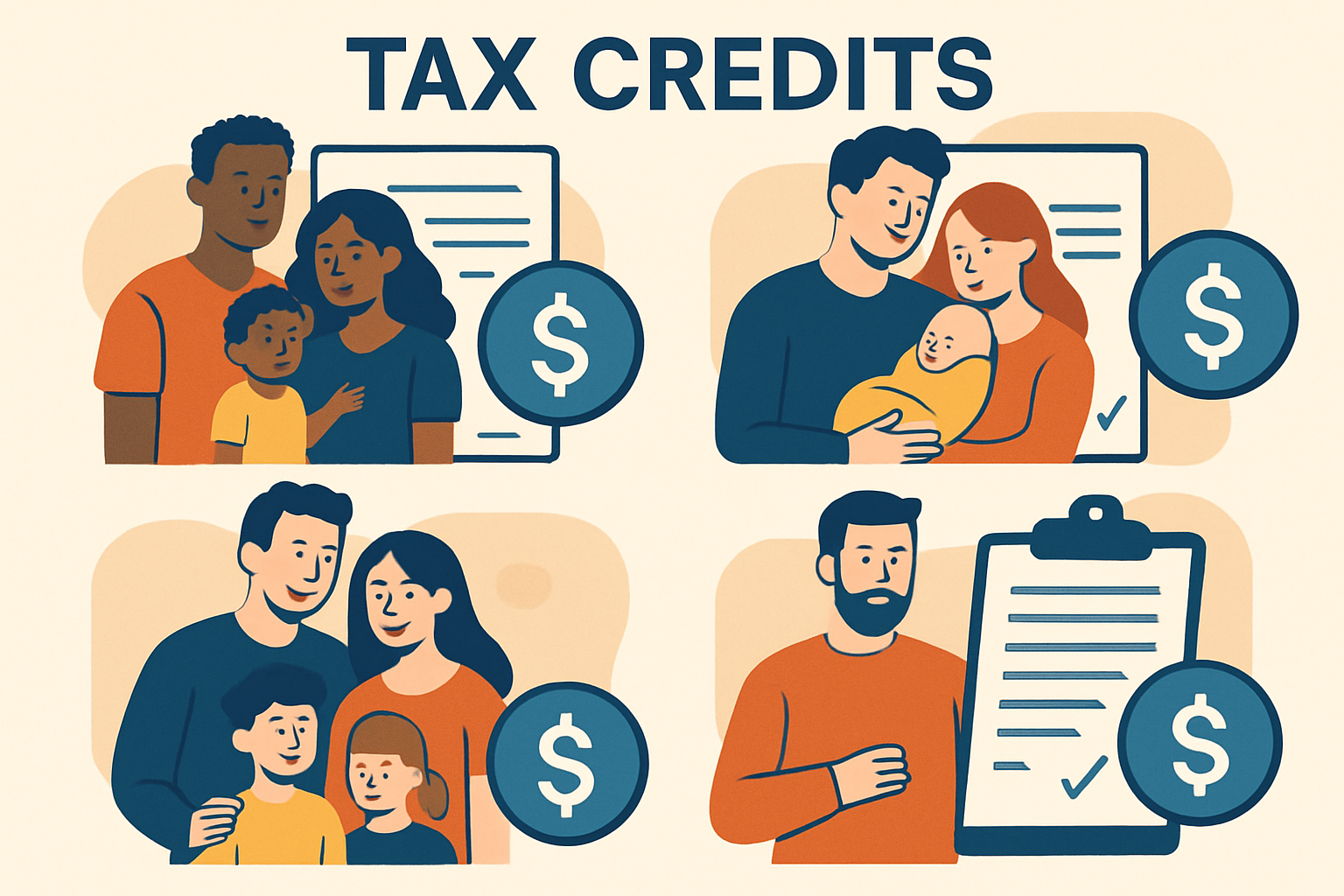Maximize Family Tax Savings: Child and Dependent Credits Explained

How the Child Tax Credit and Other Family Credits Can Lower Your Tax Bill
Families have access to several valuable tax credits that can significantly reduce their tax liability. Understanding these credits—and how to qualify for them—can help you keep more of your hard-earned money at tax time.
-
-
Child Tax Credit Basics 👨👩👧The Child Tax Credit (CTC) is designed to provide financial relief to families with dependent children. Key points include:
- • Eligibility: Generally, you must have a qualifying child under age 17 who lives with you for more than half the year and is claimed as a dependent. For example, if you have a 10-year-old who lives with you full-time and meets the IRS criteria, you may qualify.
- • Amounts💵: For tax year 2025, the maximum child tax credit per qualifying child under age 17 is $2,000. The maximum refundable portion, known as the Additional Child Tax Credit (ACTC), is $1,700 per qualifying child. This means eligible taxpayers may receive up to $1,700 as a refund even if they owe no tax.
- • Refundable vs. Nonrefundable: The refundable portion (the Additional Child Tax Credit) can result in a refund, while the nonrefundable portion can only reduce your tax bill to zero.
Example✏️: If your tax liability is $1,500 and you qualify for the full $2,000 credit, $1,500 will offset your tax bill, and you may receive a $500 refund from the refundable portion.
Child and Dependent Care Credit👶🏽👵🏼If you pay for childcare so you can work or look for work, you may qualify for the Child and Dependent Care Credit:- • Who Qualifies🧑🍼: Parents with children under age 13, or those caring for a disabled dependent. For instance, if you pay for after-school care for your 8-year-old, you may be eligible.
- • What’s Covered: A percentage of qualifying care expenses, up to $3,000 for one child or $6,000 for two or more.
- • How It Works: The credit is worth between 20% and 35% of eligible expenses, depending on your income.
Dependent Care CreditMaximum Credit AmountOne Qualifying Dependent$1,050Two or More Qualifying Dependents$2,100Example✏️: If you spend $5,000 on daycare for two children and qualify for a 30% credit, you could receive $1,500 back as a credit.
Education Credits🎓💡Families with students in college can benefit from education credits:- • American Opportunity Credit🏅: Up to $2,500 per eligible student for the first four years of college. It’s partially refundable.
- • Lifetime Learning Credit📚: Up to $2,000 per tax return for qualified tuition and related expenses, available for all years of postsecondary education.
- • Eligibility✅: Income limits apply, and you must pay qualified education expenses for yourself, your spouse, or a dependent.
Example✏️: If your child is a freshman and you pay $4,000 in tuition, you may qualify for the full $2,500 American Opportunity Credit, assuming you meet income requirements.
Income Phase-Outs and Planning🏁💡Many family credits are subject to income phase-outs:- • Child Tax Credit: Begins to phase out at $200,000 of modified adjusted gross income ($400,000 for married couples filing jointly).
- • Education Credits: These credits phase out at higher income levels. For the American Opportunity Credit and Lifetime Learning Credits, the MAGI phaseout starts at $160,000 for married couples filing jointly and $80,000 for single filers or heads of household. Check current IRS guidelines for the latest thresholds.
- • Planning Tips: If your income is hovering near a phase-out threshold, it's wise to consider various strategies that could be beneficial. For instance, contributing to retirement accounts can be a smart move, as it may help reduce your taxable income. Additionally, timing your income and deductions strategically can play a crucial role in maximizing your eligibility for certain benefits or credits.
Example✏️: A married couple earning $390,000 could contribute to a traditional IRA to reduce their modified adjusted gross income below $400,000, ensuring they qualify for the full Child Tax Credit.
ConclusionTaking advantage of family tax credits can make a meaningful difference in your tax bill. Review your eligibility each year, keep good records, and consult a tax professional if you have questions about maximizing your credits. With proper planning, these credits can provide significant financial relief for your family. -
-
-
Contact Us
If you’d like to discuss this tax planning opportunity or learn more about how tax credits for families can help reduce your tax bill, schedule time with us at your earliest convenience.
-
-
-
Date
Authors
AllTax AccountingCategories
- Tax Planning (12)
- Tax Law (9)
- Tax Deductions (8)
- Business Insights (7)
- Tax tips (7)
- OBBBA (6)
- Business Tax Tips (5)
- Business Tips (4)
- 2025 Tax Reform (3)
- State Tax Law (3)
- Tax Credits (3)
- Tax Deadlines (3)
- 1099 Reporting (2)
- 2025 Tax Rates (2)
- Bookkeeping (2)
- Gig workers (2)
- Recordkeeping (2)
- 2026 Tax Reform (1)
- Business Deductions (1)
- Home office (1)
- Investments (1)
- Maryland Tax Legislation (1)
- Penalties (1)
- QuickBooks (1)
- Real Estate (1)
- Retirement (1)
- Tax Rates (1)
- Tip Income (1)
- Trusts and Estates (1)
- Vehicle Deduction (1)
- W-2 Reporting (1)
- s-corp (1)









